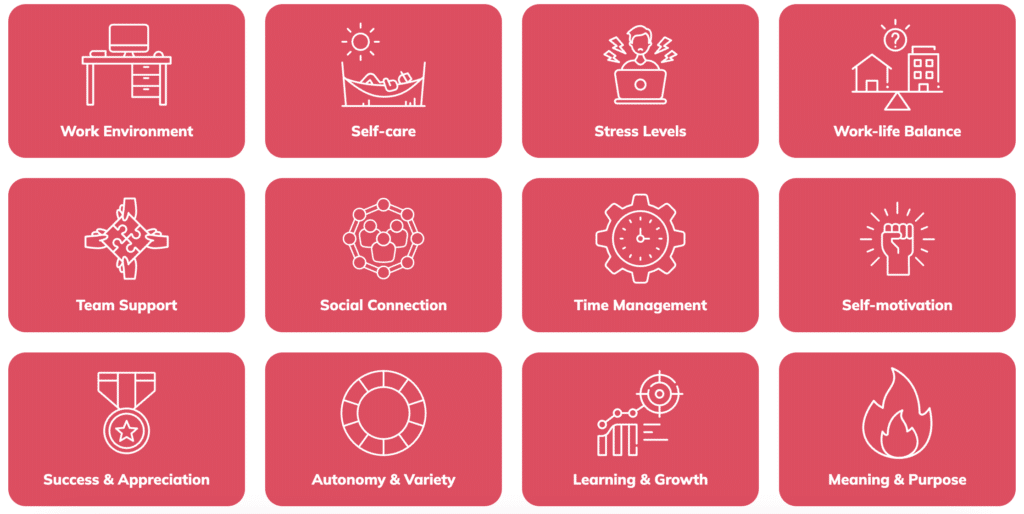How to Measure Employee Wellbeing: From Intuition to Actionable Insights

So, you’ve designed a carefully crafted wellbeing strategy to increase your business performance. But how do you know if your plans are charting your desired course – or about to sink without a trace?
While it’s often overlooked, measurement is the anchor that can turn effective strategies into exceptional ones.1 In this article, we’ll delve into the how-to of, as well as the ‘why’ behind, measuring employee wellbeing.
This isn’t about ticking boxes. It’s about using scientific insights instead of gut feelings to genuinely impact your team’s happiness and productivity. Ready to take a deeper look? Let’s set sail!
Table of Contents
Why Measure Employee Wellbeing?
It’s no secret that a happy and healthy workforce is key to a thriving business.2 It is associated with numerous beneficial outcomes such as increased productivity, job satisfaction,3 retention,4 creativity, and innovation.5 But how can you truly know how your employees feel?
That’s where measuring employee wellbeing comes into play. Here’s why it’s an essential strategy to boost the happiness, productivity, and success of your team:
Pinpoint areas of impact
Measuring employee wellness helps you pick out distinct areas that need improvement, so that you can develop targeted interventions. For example, if data shows that a particular department has a high level of stress, you can implement stress-reduction workshops or provide resources tailored to that team.
Without any form of measurement, you’re left guessing and risk spending money while still missing the mark with your employees’ unique needs. Not a great mix!
Easily Validate progress
Starting to quantify the value of your strategies is like learning to navigate by the stars rather than going wherever the wind takes you and hoping for the best.
Take a mental health programme, for example. A noticeable reduction in stress-related absences can provide the necessary proof of effectiveness, transforming a well-intentioned idea into a tangible success story.
When you’re promoting employee wellbeing, who doesn’t love a good success story which will make it easier to get more funding in the future, too?

Quickly Justify investment
Speaking of future funding .. revealing the return on investment (ROI) of your wellbeing initiatives are crucial when securing ongoing support and funding.
Imagine being able to demonstrate that every dollar spent on an employee wellness program saved $2.30 in healthcare costs while simultaneously increasing productivity.6
By measuring employee wellbeing, you can demonstrate that it actually costs your organisation more to NOT invest in wellness!
And without data like this, wellbeing can easily end up on the chopping block when cost savings need to be found.
Create accountability and transparency to build trust
Employees can feel cynical about wellness programmes, and be reluctant to take part. We get it; everyone’s busy and can struggle to see the personal benefit of taking part.
So, consistently evaluating and communicating employee wellbeing data is a public demonstration of your commitment and the benefits you deliver. It’s a testament to the fact that your wellbeing strategy isn’t just a bunch of feel-good platitudes.
Showing that it’s a serious initiative that stands up to regular scrutiny helps foster trust among your employees, and drive that crucial employee buy-in.
Catch issues early
As the old saying goes, ‘Prevention is better than cure’, and checking in on your team’s wellbeing helps to prevent problems before they even start!7
Because focusing on prevention doesn’t just make your team happier and healthier, it also saves a ton of money in the long run.
In addition to the above savings made through specific employee wellness programmes, a review published in the BMJ that investigated the ROI of existing public health interventions discovered that for every £1 spent on prevention, a whopping £14 in social benefits were returned.8 Pretty amazing, right?
If your data shows more people are feeling burned out, you can jump in early, maybe pushing for a better work-life balance, resilience workshops, wellbeing workshops or bringing in more flexible work policies.
Without data, though, you may only realise there’s a problem when it’s already too late. Ouch.

Okay, You’re Convincing Me. But What Is Employee Wellbeing, Anyway?
You’re right. It’s hard to measure something if you don’t know what it is! Here are the three components it includes:9
- Subjective Wellbeing: This is the amount of job satisfaction someone feels, as well as their levels of positive and negative feelings and emotions (ie joy and hope vs anger and anxiety).
- Eudaimonic Wellbeing: This is all about how much meaning we perceive in what we do, and the levels of personal fulfilment, motivation, contribution, and development we experience.
- Social Wellbeing: This is all about the quality of connections with our colleagues, coworkers, or leaders, and the level of social support we experience.
Choosing The Right Wellbeing Metrics
There are a whole range of ways to collect data, from surveys about employees’ perceptions of company culture to indirect approaches where you explore other data sources.
Remember, “perfect is the enemy of good”! Aim for wellbeing metrics that feel practical and manageable for your particular workplace. The key thing is establishing a solid baseline to help you track improvements and identify trends.
Popular Employee Survey Methodologies to Measure Employee Wellbeing
Employee net promoter score (eNPS) surveys10 are becoming increasingly popular as a proxy for wellbeing and a sense of belonging, measuring how likely an employee is to recommend their company to a friend or colleague. It can be a useful tool for tracking overall employee satisfaction and engagement but it does not measure all aspects of employee wellbeing, such as physical health, mental health, and work-life balance.
So consider including additional wellbeing measures, or even creating a separate survey dedicated solely to measuring wellbeing.
We know that selecting the right measure can feel overwhelming, but we’ve got your back! In this section, we’ll cover seven different measurement approaches that have been validated through research. Let’s dive in!
Directly Measuring Wellbeing
Haptivate Free Workplace Wellbeing Assessment
Our Free Workplace Wellbeing Assessment simplifies the process of monitoring employee wellbeing while removing cost barriers that many organisations face with similar tools.
It’s designed to offer a comprehensive look at the twelve drivers of workplace wellbeing, from job satisfaction to mental health, providing actionable insights tailored to your organisational needs (see image below).

Example Prompt: On a scale from 1 to 5, how effectively do you feel your workplace supports mental health?
Pros:
- Completely free of charge
- Designed with simplicity in mind, it’s easy to set up and administer, ensuring you can start quickly and without hassle.
- Provides clear, actionable steps based on the assessment results, helping you to implement meaningful wellbeing strategies effectively.
Cons:
- The success of the assessment hinges on employee participation, which requires clear communication about its benefits and confidentiality to ensure honest responses.
Warwick-Edinburgh Mental Well-being Scale (WEMWBS)
The WEMWBS11 is a self-report scale using 14 statements to measure mental wellbeing. It covers areas like positive emotions, psychological functioning, and relationships. It is easy to get a commercial licence from Warwick Medical School, and it is free for non-commercial use.12
The scale asks respondents to rate how often they have experienced certain feelings or thoughts over the past two weeks, scoring on a scale of 1 to 5, with 1 being “none of the time” and 5 being “all of the time.” The scores range from 14 to 70, with higher scores indicating better mental wellbeing, but its two-week timeframe may not accurately reflect long-term wellbeing trends.
Example Prompt: I’ve been dealing with problems well.
Pros:
- WEMWBS is user-friendly and focuses on positive mental health, making it more approachable for employees.
- It has been used in a variety of settings such as research, clinical practice, and public health, ensuring that the results are reliable and valid.
- The scale has been translated into over 25 languages, meaning that it has been widely used and validated across different populations.13
Cons:
- As it primarily measures mental wellbeing, it may not capture all aspects of workplace wellbeing, like job conditions or physical wellbeing.
- It is not a diagnostic tool.
- It can be vulnerable to social desirability bias, where we give answers that make us look good rather than reflecting how we actually feel.

Perceived Stress Scale (PSS)
The PSS is a 10-item questionnaire that measures the degree to which individuals perceive their lives as stressful. It asks respondents to rate their feelings and thoughts during the last month14 on a scale of 0 to 4, with 0 being “never” and 4 being “very often.” Its scores range from 0 to 40, with higher scores indicating higher levels of perceived stress, and it is easily found online.15
The PSS can be used to measure workplace wellbeing by asking employees to complete the scale and then tracking their scores over time. This can help employers to identify employees who are struggling with stress and to implement interventions to improve their wellbeing.
Example Prompt: In the last month, how often have you felt difficulties were piling up so high that you could not overcome them?
Pros:
- The PSS is straightforward and easy to administer, allowing organisations to quickly assess stress levels.
- It has been used in a variety of settings, including research, clinical practice, and public health, revealing it to be a reliable and valid measure of perceived stress.
- It has been translated into over 25 languages so has been widely used and validated across diverse populations.
Cons:
- The scale is not workplace-specific and may require modification for organisational settings.
- It also measures stress only, limiting its ability to capture the full spectrum of employee wellbeing.
- It can be vulnerable to social desirability bias, where we give answers that make us look good rather than reflecting how we actually feel.
The Workplace Wellbeing Survey
The Workplace Wellbeing Survey is a self-report measure that uses 23 statements to assess workplace wellbeing.16 It is based on the PERMA model of wellbeing, which was developed by Professor Martin Seligman:17
- Positive Emotion: The extent to which people feel positive emotions such as joy, contentment, and gratitude.
- Engagement: The extent to which people are absorbed, interested, and involved in their work.
- Relationships: The quality of people’s relationships with their colleagues, supervisors, and subordinates.
- Meaning: The extent to which people feel that their work is meaningful and purposeful.
- Accomplishment: The extent to which people feel a sense of accomplishment and achievement in their work.
The Workplace PERMA Profiler can be used to identify areas where wellbeing is low, and to track changes in wellbeing over time. The profiler can also be used to develop interventions to improve workplace wellbeing. An online test can be found at a Permah Survey,18 and as a PDF via the creator Peggy Kearn’s website.19
Example Prompt: In general, to what extent do you feel that what you do at work is valuable and worthwhile?
Pros:
- It is a well-validated measure of workplace wellbeing.
- It is easy to administer and score.
- It can be used to measure wellbeing at the individual, team, or organisational level.
Cons:
- It is a self-report tool, so it is subject to bias.
- It does not measure all aspects of workplace well-being.
- It can be time-consuming to complete.

Other Wellbeing-Related Approaches
Job Satisfaction Survey (JSS)
The JSS is a 36-question survey that measures job satisfaction across nine dimensions: pay, promotion, fringe benefits, contingent rewards, operating procedures, coworkers, nature of work, communication, and supervision.20 It asks respondents to use a 6-point scale, going from “disagree very much” to “agree very much”.
It is a well-validated instrument that has been used in a variety of settings.21 It can be used to identify areas where there are problems and track changes in job satisfaction over time. It has been translated into 30 languages, and is available as an online test or downloadable PDF with additional support on the creator Dr Paul Spector’s website.22
Example Prompt: When I do a good job, I receive the recognition for it that I should receive.
Pros:
- The JSS offers a comprehensive assessment of job satisfaction, allowing organisations to identify specific areas for improvement.
- It is well-established and has strong reliability and validity.
- It can be used to track changes in job satisfaction over time.
Cons:
- The scale’s length may be a drawback for busy employees, potentially affecting response rates.
- It exclusively focuses on job satisfaction and may not capture broader aspects of employee wellbeing and items like physical wellness.
Utrecht Work Engagement Scale (UWES)
The UWES23 measures employee engagement through scoring 17 statements, with participants rating their experiences on a 7-point scale from “never” to “always/every day”. It assesses three key categories:
- Vigour – energy and resilience
- Dedication – emotional connection and investment in work
- Absorption – ability to immerse in work and enter flow.
The UWES can be used to measure workplace wellbeing by identifying areas where work engagement is low. These areas can then be targeted for improvement, which can lead to a more positive and productive workplace. The original English version can be found in the appendix of the freely available research paper.24
Example Prompt: I am proud of the work that I do.
Pros:
- The UWES specifically targets employee engagement, an essential aspect of wellbeing linked to employee satisfaction.25
- Research shows that engaged employees are associated with higher productivity and better performance at the organisational level.26
- It has been extensively validated and translated into multiple languages.
Cons:
- The scale focuses solely on employee engagement, which may not provide a comprehensive view of overall employee wellbeing.
- It may require some adaptation for specific organisational contexts.
Psychological Capital Questionnaire (PCQ)
The PCQ consists of 24 questions to assess the positive psychological resources that contribute to employee wellbeing and performance. It does so by exploring four components: self-efficacy, hope, optimism, and resilience:27
- Hope: The belief that one can achieve one’s goals, even when faced with challenges.
- Self-efficacy: The belief in one’s own ability to succeed.
- Resilience: The ability to bounce back from setbacks and challenges.
- Optimism: The belief that good things will happen in the future.
Respondents answer statements on a 6-point scale from “strongly disagree” to “strongly agree”. Developed by management professors Fred Luthans, Bruce J. Avolio, & James B. Avey.28
Example Prompt: I can get through difficult times at work because I’ve experienced difficulty before.
Pros:
- It has strong reliability and validity and is applicable across various industries.29
- It has been designed for working adults and published research connects it to “lower employee absenteeism, higher job satisfaction, commitment, and organisational citizenship behaviours”.
- There is a less-known free version (PSQ-12) with only 12 items.30
Cons:
- The scale focuses on psychological capital, which may not fully track employee wellbeing in its entirety.
- The full scale is copyrighted for commercial use, limiting its accessibility for some organisations.
The above metrics might seem a bit overwhelming at first glance! But it’s perfectly acceptable to use these methods as a source of inspiration and select a subset of questions that feel right for your organisation.
Remember, you can always start with a basic approach and then implement something a bit more advanced further down the line when you’re looking for a greater depth of insight to support your wellbeing improvements.
Get free access to wellbeing resources, news and research
Get access to the exclusive Haptivate Wellbeing Resource Hub and stay up to date with all the latest wellbeing at work research, tools and tips by joining our monthly newsletter. We promise not to share your data or spam you with irrelevant information 🙂
An Important Note On Data Protection
Before diving into the methods, here’s a quick note on monitoring employee mental health and physical health. When you’re collecting any data about mental health or physical health, there are legal considerations to be aware of.
Employee health data falls under the category of sensitive personal information, so how it is collected, stored, used and accessed should be tightly controlled.
Under the General Data Protection Regulation (GDPR) and Data Processing Agreement (DPA), any processing of personal data must have a specific, explicit and legitimate purpose. There are also a number of requirements on human rights grounds:
- You must collect only the information necessary for a specific purpose(s);
- You should only hold as much data as required, for as long as required;
- You must allow the employee to see it on request
- You must keep the information secure.
It is recommended that any data you collect that relates to employee health is anonymised and that analysis is carried out at an aggregated level – e.g., on the team or department level – so data cannot be tied back to an individual. This can still provide a wealth of valuable insights that can help to support and improve employees’ health.
Okay, now that we’ve covered the legal stuff, let’s get into the indirect methods of how to measure wellbeing…
Other Key Data Sources to Leverage
HR Data
Your strategy for measuring wellbeing doesn’t have to be exclusively survey-driven. HR systems house a treasure trove of data that, when analysed thoughtfully, can offer invaluable insights into employee wellbeing.
This data can empower you to craft and deliver initiatives that encourage a more satisfied and healthier workforce:
Attendance and Absenteeism
One of the most straightforward methods to gauge employees’ wellbeing is by examining attendance and absenteeism patterns.
Unsurprisingly, high rates of absenteeism may indicate employee disengagement, burnout, or other wellbeing issues.31
You should look for patterns such as frequent sick days or a rise in mental health-related absences, to identify areas where targeted interventions may be necessary.
Employee Turnover Rates
High employee turnover rates can signal dissatisfaction and a decline in overall wellbeing.32
By closely monitoring turnover rates, HR can identify departments or teams experiencing low levels of employee satisfaction and take proactive measures to improve the working environment.
Performance Metrics
Employee performance metrics, such as productivity, quality, and efficiency, can also serve as indicators of wellbeing. Research suggests that employees with higher levels of wellbeing tend to perform better in their roles.33
You can analyse performance data to discover areas where wellbeing interventions may lead to improvements in employee performance and satisfaction.
Take-Up of Wellbeing Programmes
Measuring the level of employee participation in your existing wellbeing initiatives can help you to determine their effectiveness.
Low pick-up rates may reveal a need for better communication, more relevant program offerings, or adjustments to better fit with your employees’ needs.34

Data From Communication And Workflow Management Platforms
Workload and time management
Are your projects plain sailing, or are you tossed about by frequent storms?
By analysing the volume and frequency of the tasks assigned and completed through your existing project management platforms, you can assess whether your employees are overburdened and struggling to manage their workload.
High task volumes or consistently missed deadlines may indicate excessive workload or poor time management,35 both of which can hurt wellbeing.
Work hours and work-life balance
In this always-on culture, the timestamps on emails or instant messages can give you an idea of employees’ work hours.
If your employees are consistently sending emails or messages outside of normal working hours or on weekends, it may indicate a lack of work-life balance, which can contribute to burnout and negatively affect wellbeing.36
Responsiveness and engagement
While you don’t want everyone to always be “on”, keeping an eye on the response times to emails or messages can also provide insights into employee engagement.
Longer response times or a drop in responsiveness over time could signal disengagement or high stress levels, which can affect mental health and overall wellbeing.
Tone and sentiment analysis
Analysing the tone and sentiment of messages exchanged between employees can help identify potential signs of stress, frustration, or low morale.
Sentiment analysis tools can be used to detect negative emotions in written communication, providing an indirect indicator of employee wellbeing.
Collaboration and social connections
Observing the patterns of communication and collaboration between your team members can help you understand the quality of workplace relationships.
High levels of collaboration and positive communication may indicate strong social connections, which can contribute to better wellbeing at work.37

That’s a wrap!
Okay, the shore is in sight! We hope that you now understand how to measure employee happiness at work, their wellbeing, the ‘why’ behind measuring it, and the different methods available to understand your team at a deeper level.
Jumping into using wellbeing business metrics might feel like learning a new language, but believe us, it’s a game-changer.
These metrics are your secret weapon. They can help you pinpoint what needs attention, confirm your efforts are paying off, and reveal the return on your investment.
Of course, your workplace is unique, so your chosen metrics should reflect your specific context and challenges.
If you’re curious to learn more about how to use metrics and tackle other aspects of wellbeing programme development, check out our article about developing a wellbeing programme. It’s a roadmap for crafting initiatives that resonate with your team and deliver real benefits.
By combining insightful surveys, HR data, and clever analytics, you can piece together a fairly comprehensive picture of wellbeing in your organisation. These nuggets of knowledge will help you to build strategies that truly float your team’s boat.
Employee wellbeing isn’t a one-time thing. It’s about continually exploring, learning, and fine-tuning. Entering unknown waters may feel daunting, but the end goal – a happier, healthier, and more productive team – is absolutely worth charting a course for.

Aysha Frost
Digital Marketing
Get in touch
Other articles that may interest you…
10 Top Wellbeing at Work Ideas From Leading Organisations
Mental Health First Aid (MHFA): How Can It Enhance Wellbeing at Work?
How to Build a Successful Employee Wellbeing Programme
The Complete Guide To Remote Work Wellbeing, Stress & Resilience For Businesses & Managers
- https://psycnet.apa.org/record/2014-09726-002
- https://books.google.com.au/books?hl=en&lr=&id=YVAQVa0dAE8C&oi=fnd&pg=PA1&dq=+happiness+and+wellbeing+at+work&ots=debLAfCXZR&sig=GOXcD1yy_pM3Q3yB7hKYgqdvijg&redir_esc=y#v=onepage&q=happiness%20and%20wellbeing%20at%20work&f=false
- https://onlinelibrary.wiley.com/doi/full/10.1111/j.1468-2370.2009.00270.x?casa_token=Di8aF0WXlUUAAAAA%3ApX35KeCkyqOL2B_mdZ6f0H0gy7uGtDVifJGghQHEHsgEUlANF57NdP1wSdgGaRdzF9AH8X-xdps084vd
- https://link.springer.com/article/10.1007/s11125-015-9372-z
- https://www.tandfonline.com/doi/full/10.1080/00036846.2020.1828807?casa_token=muPkjPVQKnoAAAAA%3ArQ4Mj9MpKE-H9CismvdlLzcv84c41p9aumzDxZZr2cVdUqM05EYqjC22DuV6SyJCrvZvPRgv4hfE4w
- https://haptivate.co.uk/blog/how-to-make-a-compelling-business-case-for-wellbeing-at-work-build-an-roi-model-to-secure-a-budget-with-these-4-simple-numbers/
- https://assets.publishing.service.gov.uk/government/uploads/system/uploads/attachment_data/file/753688/Prevention_is_better_than_cure_5-11.pdf
- https://jech.bmj.com/content/71/8/827
- https://psycnet.apa.org/record/2014-09726-002
- https://www.nashc.net/wp-content/uploads/2014/10/the-one-number-you-need-to-know.pdf
- https://link.springer.com/article/10.1186/1471-2458-11-487
- https://warwick.ac.uk/fac/sci/med/research/platform/wemwbs/using
- https://link.springer.com/article/10.1007/s11136-013-0513-7
- https://psycnet.apa.org/doiLanding?doi=10.1037%2Ft02889-000
- https://novopsych.com.au/assessments/well-being/perceived-stress-scale-pss-10/
- https://www.internationaljournalofwellbeing.org/index.php/ijow/article/view/526
- https://ppc.sas.upenn.edu/learn-more/perma-theory-well-being-and-perma-workshops
- https://permahsurvey.com/workplace/
- https://www.peggykern.org/questionnaires.html
- https://pubmed.ncbi.nlm.nih.gov/4083275/
- https://www.researchgate.net/profile/Mohammad-Gholami-Fesharaki/publication/288295309_Reliability_and_validity_of_Job_Satisfaction_Survey_questionnaire_in_military_health_care_workers/links/57aed90708ae15c76cb73f6f/Reliability-and-validity-of-Job-Satisfaction-Survey-questionnaire-in-military-health-care-workers.pdf
- https://paulspector.com/assessments/pauls-no-cost-assessments/job-satisfaction-survey-jss
- https://www.researchgate.net/publication/237937572_The_Measurement_of_Work_Engagement_With_a_Short_QuestionnaireA_Cross-National_Study
- https://www.researchgate.net/publication/237937572_The_Measurement_of_Work_Engagement_With_a_Short_QuestionnaireA_Cross-National_Study
- https://sciendo.com/article/10.1515/ethemes-2017-0014
- https://www.sciencedirect.com/science/article/pii/S1053482215000509?casa_token=ZfBDj_Jh5w8AAAAA:Pv7wGuJFD-f62ihaUXeMLqSAlO7WdBca1Huwv8jkNGtGZSAvavBjyYMBfTyrsbluatVFfaqX1d0
- https://psycnet.apa.org/doiLanding?doi=10.1037%2Ft06483-000
- https://www.mindgarden.com/136-psychological-capital-questionnaire
- https://psycnet.apa.org/doiLanding?doi=10.1037%2Ft06483-000
- https://www.ncbi.nlm.nih.gov/pmc/articles/PMC8508554/
- (Koopman et al., 2009)
- (Ton & Huckman, 2008)
- https://onlinelibrary.wiley.com/doi/pdf/10.1111/j.1468-2370.2011.00322.x?casa_token=KsSJxQuCaEMAAAAA:GXuwT7inY-oJW4ohX1Jp6h0NM-ZWG2lQjR6g5SjyiHinzUWRICdOejcmKyn3mzguuENXF7dT1Zn4zAfr
- (Goetzel et al., 2007)
- https://onlinelibrary.wiley.com/doi/epdf/10.1111/j.1468-2419.2005.00226.x
- https://journals.plos.org/plosone/article?id=10.1371/journal.pone.0055189
- https://link.springer.com/chapter/10.1007/978-3-030-70228-1_5







